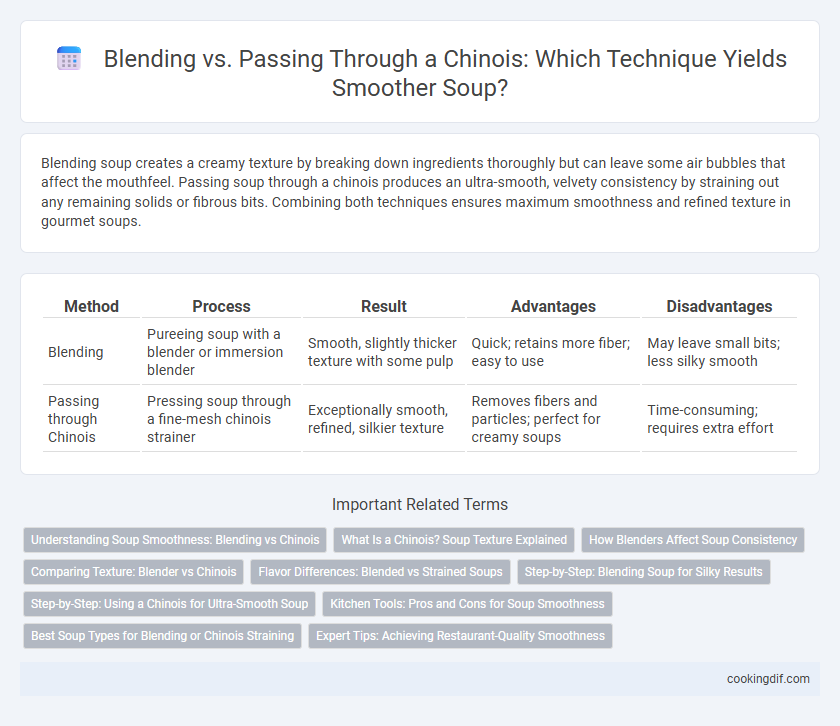Blending soup creates a creamy texture by breaking down ingredients thoroughly but can leave some air bubbles that affect the mouthfeel. Passing soup through a chinois produces an ultra-smooth, velvety consistency by straining out any remaining solids or fibrous bits. Combining both techniques ensures maximum smoothness and refined texture in gourmet soups.
Table of Comparison
| Method | Process | Result | Advantages | Disadvantages |
|---|---|---|---|---|
| Blending | Pureeing soup with a blender or immersion blender | Smooth, slightly thicker texture with some pulp | Quick; retains more fiber; easy to use | May leave small bits; less silky smooth |
| Passing through Chinois | Pressing soup through a fine-mesh chinois strainer | Exceptionally smooth, refined, silkier texture | Removes fibers and particles; perfect for creamy soups | Time-consuming; requires extra effort |
Understanding Soup Smoothness: Blending vs Chinois
Blending soup breaks down ingredients thoroughly, creating a creamy texture ideal for pureed vegetables and fruits, while passing soup through a chinois removes seeds, skins, and fibrous bits for an ultra-smooth, velvety finish. Understanding the difference is essential for achieving desired mouthfeel: blending offers fullness and body, whereas using a chinois refines texture by straining out impurities and solids. Chefs prioritize chinois when clarity and silkiness are crucial, particularly in consommes or fine sauces.
What Is a Chinois? Soup Texture Explained
A chinois is a fine-mesh conical sieve used to strain soups, sauces, and custards, providing an ultra-smooth and velvety texture by removing solids and impurities. Unlike blending, which purees ingredients and leaves some pulp or fibers, passing soup through a chinois ensures a refined consistency by filtering out any remaining particles. This process is essential for achieving professional-quality smoothness in classic French soups and consommes.
How Blenders Affect Soup Consistency
Blenders create a creamy, thick soup by fully breaking down ingredients, incorporating air and resulting in a smooth, velvety texture ideal for purees and bisques. Passing soup through a chinois produces an ultra-fine, silky consistency by straining out seeds, skins, and fibers, perfect for refined presentations. The choice between blending and using a chinois directly impacts the mouthfeel, with blenders offering more body and a heartier texture, while a chinois ensures an elegant, clear finish.
Comparing Texture: Blender vs Chinois
Using a blender to achieve soup smoothness results in a creamy, slightly thicker texture due to the retention of fine pulp and fiber, enhancing mouthfeel and body. Passing soup through a chinois produces an ultra-silky, refined texture by straining out solids and fibers, ideal for delicate consommes or veloute soups. The choice between blending and chinois depends on the desired soup consistency, with blenders offering fullness and richness, while a chinois delivers perfect silkiness and clarity.
Flavor Differences: Blended vs Strained Soups
Blending soup preserves the natural fibers and enriches the body, resulting in a heartier, more textured flavor profile, while passing it through a chinois creates an ultra-smooth, refined consistency that highlights delicate, subtle notes. Strained soups often have a cleaner taste, allowing individual ingredients like herbs or spices to shine without interference from pulp or fibrous bits. Chefs choose blending for robust, rustic flavors and chinois straining to achieve elegant, silky finishes prized in fine dining.
Step-by-Step: Blending Soup for Silky Results
Blending soup using an immersion blender breaks down ingredients quickly, creating a smooth, creamy texture, while passing the soup through a chinois refines the mixture by straining out any remaining fibers or seeds for ultra-silky results. Step-by-step, start by blending the soup in small batches until uniformly smooth, then pour it through the chinois using a ladle or spatula to gently press the soup through the fine mesh. This two-step approach ensures maximum smoothness, ideal for velvety purees and elegant soups like bisques or cream-based varieties.
Step-by-Step: Using a Chinois for Ultra-Smooth Soup
For ultra-smooth soup, start by blending ingredients until fully pureed. Pour the blended soup through a chinois, applying gentle pressure with a pestle or ladle to extract the finest texture. This straining method removes any remaining solids, producing a velvety finish ideal for creamy bisques and delicate consommes.
Kitchen Tools: Pros and Cons for Soup Smoothness
Blending soup using an immersion blender quickly turns ingredients into a smooth puree, retaining more fiber and nutrients but sometimes leaving small air bubbles that affect texture. Passing soup through a chinois sieve removes lumps and seeds, producing an ultra-smooth, velvety consistency ideal for refined presentations but requires more time and effort. Choosing between blending and using a chinois depends on balancing desired smoothness, texture, and preparation time in professional or home kitchens.
Best Soup Types for Blending or Chinois Straining
Blending soups like creamy tomato, butternut squash, or potato leek preserves fiber and creates a velvety, thick texture ideal for hearty meals. Delicate soups such as consommes, bisques, and refined vegetable purees benefit from passing through a chinois, which removes any lumps or seeds to produce an ultra-smooth, elegant finish. Choosing the right method enhances mouthfeel and presentation based on the soup's ingredients and desired consistency.
Expert Tips: Achieving Restaurant-Quality Smoothness
Blending soup ensures even texture with retained nutrients, while passing through a chinois removes impurities and creates an ultra-smooth finish favored in high-end kitchens. Experts recommend using a high-powered blender to break down ingredients fully before straining through a fine-mesh chinois for that signature velvety consistency. This two-step process achieves restaurant-quality smoothness by combining thorough pureeing with meticulous filtration.
Blending vs Passing through chinois for smoothness Infographic

 cookingdif.com
cookingdif.com